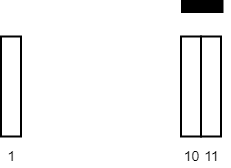LeetCode in Kotlin
2271. Maximum White Tiles Covered by a Carpet
Medium
You are given a 2D integer array tiles where tiles[i] = [li, ri] represents that every tile j in the range li <= j <= ri is colored white.
You are also given an integer carpetLen, the length of a single carpet that can be placed anywhere.
Return the maximum number of white tiles that can be covered by the carpet.
Example 1:

Input: tiles = [[1,5],[10,11],[12,18],[20,25],[30,32]], carpetLen = 10
Output: 9
Explanation: Place the carpet starting on tile 10.
It covers 9 white tiles, so we return 9.
Note that there may be other places where the carpet covers 9 white tiles.
It can be shown that the carpet cannot cover more than 9 white tiles.
Example 2:

Input: tiles = [[10,11],[1,1]], carpetLen = 2
Output: 2
Explanation: Place the carpet starting on tile 10.
It covers 2 white tiles, so we return 2.
Constraints:
1 <= tiles.length <= 5 * 104tiles[i].length == 21 <= li <= ri <= 1091 <= carpetLen <= 109- The
tilesare non-overlapping.
Solution
class Solution {
fun maximumWhiteTiles(tiles: Array<IntArray>, carpetLength: Int): Int {
tiles.sortWith { x: IntArray, y: IntArray -> x[0].compareTo(y[0]) }
var currentCover = Math.min(tiles[0][1] - tiles[0][0] + 1, carpetLength)
var maxCover = currentCover
var head = 1
var tail = 0
while (tail < tiles.size && head < tiles.size && maxCover < carpetLength) {
if (tiles[head][1] - tiles[tail][0] + 1 <= carpetLength) {
currentCover += tiles[head][1] - tiles[head][0] + 1
maxCover = Math.max(maxCover, currentCover)
++head
} else {
val possiblePartialCoverOverCurrentHead = carpetLength - (tiles[head][0] - tiles[tail][0])
maxCover = Math.max(maxCover, currentCover + possiblePartialCoverOverCurrentHead)
currentCover = currentCover - (tiles[tail][1] - tiles[tail][0] + 1)
++tail
}
}
return maxCover
}
}

